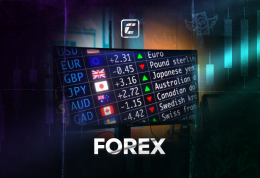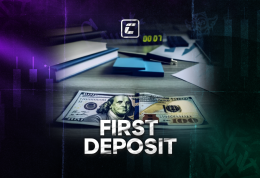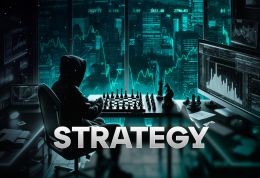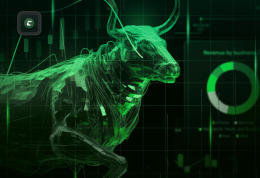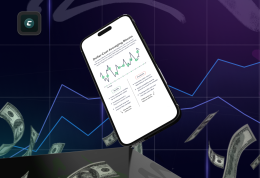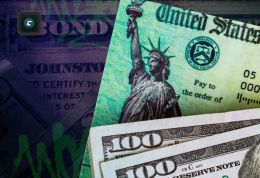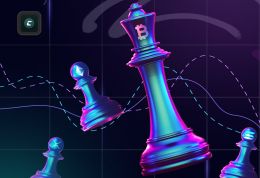Where to start trading: a complete guide for beginning traders
What is trading?

Simply put, trading is a type of trading activity aimed at making a profit. The people involved in these operations are called traders. They can trade almost anything, from wheat or precious metals to bitcoin and stocks.
The market brings together a variety of participants, including individual investors, large corporations, and financial institutions that interact with financial instruments such as:
- Company shares - shares in the ownership of companies that entitle you to a portion of their profits and assets.
- Derivatives are complex financial instruments whose value is derived from the underlying asset. Simply put, think of derivatives as a bet on the future price of something based on the current value of other assets. For example, when making a contract with a friend for the future purchase of a video game, you are basing the price of popular sneakers today. If the price of sneakers increases, the price of the video game in your contract will likely increase as well. This allows market participants to speculate on price changes without directly owning the asset itself.
- Commodities - physical or primary products, such as oil, gold or grain, traded on specialized exchanges.
Trading, first and foremost, is a limitless world of unfamiliar terms. To make it easier for you to navigate, we have prepared a comprehensive dictionary on our Basecamp platform that will be your guide to trading.
We offer you direct access to the fundamental knowledge you need to successfully start trading. This resource is free of charge and is specifically designed to make the learning process as simple and straightforward as possible.
Where does trading take place?
There are many markets, each with its own unique characteristics and offering a variety of assets to trade. Among them stand out:
- Cryptocurrency market, where bitcoin, etherium and thousands of other cryptocurrencies are traded.
- Forex (foreign exchange market), which offers trading opportunities in currency pairs such as EUR/USD, GBP/JPY and many others.
- The stock market, where traders can buy and sell shares of the world's leading companies.
- And other markets including commodity markets where oil, gold and agricultural products are traded, as well as derivatives markets where options and futures are available.
In order to become a participant in these markets and start trading, traders use the services of intermediaries - brokers (exchanges). In the modern world, these roles are often performed by specialized trading platforms that provide access to multiple markets through a single interface: for example, in order to trade cryptocurrency, a broker is not needed, it is enough to register on the WhiteBIT exchange, for example, and start trading.
Exchanges and brokers act as a bridge between traders and the market, facilitating the process of buying and selling assets. They provide tools to analyze the market, execute trades and manage risks.
Who can become a trader?
Trading is open to anyone who is financially active and willing to learn the field, regardless of age or professional background. The entry threshold to financial markets is lowered thanks to digitalization and the availability of educational resources.
For example, with as little as $100 in seed money and access to the internet, you can already start your journey in trading, for example in the crypto market.
Interesting fact: According to a survey conducted by the financial portal Investing.com in 2021, about 35% of beginning traders reported that they started their trading activities with an investment of less than $500. Of this group, a significant number of those surveyed saw their initial capital grow thanks to a strategic approach to trading and market analysis.
Becoming a successful trader is not just about financial investment, but also about a number of qualities such as:
- Analytical mind: the ability to analyze large amounts of data and highlight important trends in the market.
- Discipline: adherence to a developed trading plan and risk management.
- Quick reaction: the ability to make decisions under conditions of high uncertainty and changing market conditions.
For those starting out without significant start-up capital, there are ways to build it up, including participating in trading contests on demo accounts, using micro-lots in forex, or investing in fractional shares in the stock market. For example, some brokerage platforms offer beginners virtual funds for learning to trade, allowing them to learn the basics and develop their strategy without risking real funds. In addition, with a small capital, a trader can always try a challenge in a proprietary firm and get from $5,000 to $200,000+ to manage.
What types of trading are there?
Let's take a look at three key types of trading, each of which offers unique opportunities and strategies for actively participating in the financial markets.
- Scalping - a type where a trader makes money on micro price movements by working with minimal timeframes, such as minute timeframes. This requires continuous attention and quick decisions.
- Medium-term trading here traders work with older timeframes - from an hour to several days. This approach allows you to thoroughly analyze the market and make informed decisions without rushing. This strategy is especially suitable for market participants who find it difficult to constantly monitor the market situation throughout the day.
- Long-term trading is a strategy for those who prefer to analyze and invest based on economic trends and macroeconomic indicators.
What are candles, timeframes, charts?
Charts
Trading charts or charts are diagrams that show fluctuations in the value of assets over a selected period of time (timeframe).
.png)
Candlestick interpretation
The color of a candlestick indicates the direction of price movement during the selected time interval: always white color of a candlestick means price growth, and black color - its decrease.

Understanding timeframes in trading
Timeframes in trading - (timeframe - a period of time) are time intervals over which charts of asset prices, such as stocks or currencies, are plotted. On these charts, each candlestick or line shows how the price has changed during the selected time. Thus, traders can analyze how prices have changed over the course of a day, week, month and so on to make buy or sell decisions.
The choice of timeframe depends on the trader's strategy and can greatly influence trading decisions. Timeframes can range from very short (e.g. a minute) to long (e.g. a month), allowing traders to adapt to different trading styles and objectives.
Junior timeframes
Short timeframes (one minute, 5 minutes, 15 minutes) are often used by dey traders and scalpers seeking quick profits from small price fluctuations. These timeframes require constant attention and quick reaction to market changes.
Senior timeframes
Long timeframes (weekly, monthly) are used by long-term investors and traders interested in analyzing long-term trends and economic fundamentals. These timeframes require patience and long-term planning.
Selecting a timeframe
Of course in the beginning of your journey, you will try different timeframes. Using the 15-minute and hourly will be the most comfortable for beginners. You will also be able to stay on them or continue trading on others, the only difference is how long you are willing to be in one position.
When choosing a timeframe for trading, it is also important to consider the timeframe synchronization strategy. This is an approach where traders use multiple timeframes at the same time to get a more complete picture of an asset's price movement.
For example, you might start by looking at the daily chart to determine the general direction of the trend, and then move on to the hourly or 15-minute chart to look for entry and exit points.
Synchronizing timeframes allows you to better understand the market and make more informed trading decisions. This method is especially useful for avoiding false signals that can occur when analyzing only one timeframe. Using synchronization, traders can confirm their forecasts by comparing information on different timeframes, thus increasing the probability of a successful trade.
Thus, using this approach, you can customize your trading strategy more flexibly, adapting to different market conditions and taking into account both long-term trends and short-term price fluctuations. This requires more time and attention, but ultimately gives the trader a deeper understanding of the market and increases the chances of success.
What books can be read by a beginning trader?
To start trading with confidence, master the following fundamental resources:
- "The Disciplined Trader" by Mark Douglas
- "The Great Hedge Fund Magicians. Traders Who Don't Lose" by Jack D. Schwager.
- М. Bellafiore "One Good Trade."
- Brett Steenbarger "The Psychology of Trading"
- Д. Kahneman "Think Slowly, Decide Fast"
- Curtis Feis "The Way of the Turtle"
- Eric Nyman "The Small Encyclopedia of the Trader".
- Nassim Taleb "Fooled by chance. On the hidden role of chance in business and in life"
These books serve as a base for beginning traders. With their help you can "get into" the very life of a trader, learn from the experience of successful market players and even learn something for yourself.
However, remember that books are only a tool, and it is not always the most effective one. There are no answers and solutions for trading in them, but there is information that can expand your knowledge in the sphere.
Can trading be your main job?
Of course it can. If you trade successfully for at least 3 months in a row, with profits that cover your monthly expenses, you can think about leaving your job to trade. However, this is a very important step.
Trading is a full-fledged profession that has been around for over a hundred years. Bankers, traders and economists have been working on Wall Street for decades and make money by buying and selling assets. Earlier, in order to become a trader, a person had to get a proper education and attend trades in the stock exchange building every day. With the advent of the information space, more opportunities have opened up in front of people: now everyone can create an account on the stock exchange or start working with a broker and start trading, but of course, you need knowledge to do this. With the right knowledge you can earn just like in any other field. Remember that trading is a profession like marketing or IT, but you are your own boss: you determine the time and place of work, goals and development strategies. In this way you take all the risks on yourself.
Form a financial safety cushion before you fully switch to trading. Remember that you should never trade on your last money - it will lead to losses and loss of motivation.
The key aspect is your trading capital, which determines the amount of money you earn each month. Accumulate money to build up a larger deposit or try your hand at pro trading, where paying $100 for a challenge can get you $10000 to manage.
Start with our Basecamp where you can get a successful start and get the basics down.
And remember that you should never stop learning: a successful trader is always learning new things. Besides, to work successfully on the markets it is extremely important to be able to control your emotions and risks, follow your trading strategy and keep a trading journal.
A course for beginners from CRYPTOLOGY x WhiteBIT
You should start your way in the markets first of all with training, because without it not only you will not be able to earn steadily on the distance, but also a very high risk of losing everything you started with.
Before choosing a full-fledged course, you can find a way out in free training.
In order to ensure a comfortable start in trading, we and our partners WhiteBIT have prepared a completely free course for beginners. By taking it, you will not only learn how the markets function, but also get a clear idea of what tools exist for analyzing charts and how to use them. Our experts will share their experience and advice with you, tell you about the importance of trading strategy and how to make it, you will get all the important information that will allow you to build your plans for further work and training in trading.
By enrolling in our course, you will not just get a new skill, you will start mastering a new profession. In addition to video lessons, you will also get additional bonuses in the form of manuals, which you can always refer to even after the course is over.
Action plan for a beginner trader from Cryptology team
When you decide to learn trading, after learning the basics, it may seem too difficult. However, if your desire to continue hasn't faded, here are some actionable recommendations.
Don't rush to devour all the recommended books at once. They are just one of the tools of learning. The first stages of your way will be covered by our free Basecamp course, where you will master the base and find a further vector of development.
Open a demo account at the exchange of your choice and start experimenting with different assets and markets using conditional funds. You can do without a demo account and try yourself on a small deposit, for example, $100. This step will allow you to gain the necessary experience in trading without risking a lot of money. Despite this, it is important not to get stuck at the virtual trading stage for too long. Eventually, in order to develop real trading skills and gain practical experience, you need to move on to trading with real funds. The sooner you start real trading, the sooner you will be able to adapt to the market dynamics and start making money
Remember the importance of backtesting strategies on historical data. Backtesting is extremely useful for traders as it allows them to evaluate the effectiveness of a trading strategy.
Choose the exchange wisely. Analyze, look at reviews.
After these steps, you are ready to start real trading. Immerse yourself in analyzing data, master the theoretical basics.
But remember: if you dig up a seemingly working strategy, be sure to test it on a demo account before you risk real money. And in general, take risks seriously.
Continuous self-improvement, skill development and striving for progress are key aspects of a successful trading career. Always strive to improve your skills and knowledge, learn new methods and approaches, exchange experience with other traders and regularly participate in educational programs. This will not only strengthen your skills, but also help you adapt to the ever-changing market conditions.
It is important to realize that being a trader is like developing your own business, where gradually, using the accumulated knowledge, you build up your capital. And eventually you find out that you can extract enough money for a comfortable life. But there are a lot of challenges to go through until then!
Frequently asked questions
What are candles, timeframes and charts in trading?
Timeframes are time intervals on which charts are plotted (e.g. minute, hour, day).






